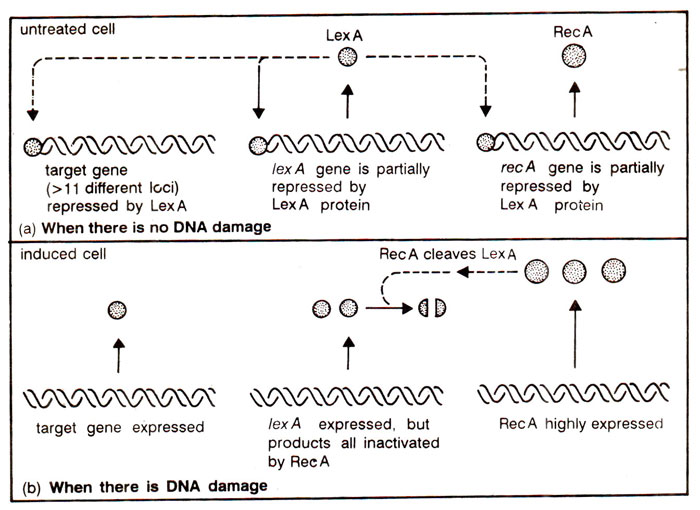An SOS repair system in E. coli
An SOS repair system in E. coli
In E. coli, many treatments causing DN/ damage or inhibition of DNA replication, induce a complex series of phenotypic changes described as SOS response. The SOS response (increased capacity to repair damaged DNA) is initiated by interaction of RecA protein with LexA repressor. Following steps are involved : (i) damaging treatment activates RecA protein (a protease), through common intermediates (small DNA molecules or single stranded region); (ii) RecA protease interacts with LexA repressor (coded by lex A gene) and due to proteolytic action of RecA on LexA, all operons to which LexA is bound are induced (Fig. 26.35); these may include a number of operons/genes called din (damage inducible) genes, such as uvr A, uvr B, uvr C and hin A. These genes each has a SOS box, 20 bp long having a 8 bp long consensus sequence. Since LexA represses its own synthesis and that of RecA, its proteolytic degradation leads to amplification of both LexA and RecA proteins. However, when DNA damaging signal is removed, RecA is not induced and LexA accumulates, which represses all other genes belonging to SOS system.
In E. coli, many treatments causing DN/ damage or inhibition of DNA replication, induce a complex series of phenotypic changes described as SOS response. The SOS response (increased capacity to repair damaged DNA) is initiated by interaction of RecA protein with LexA repressor. Following steps are involved : (i) damaging treatment activates RecA protein (a protease), through common intermediates (small DNA molecules or single stranded region); (ii) RecA protease interacts with LexA repressor (coded by lex A gene) and due to proteolytic action of RecA on LexA, all operons to which LexA is bound are induced (Fig. 26.35); these may include a number of operons/genes called din (damage inducible) genes, such as uvr A, uvr B, uvr C and hin A. These genes each has a SOS box, 20 bp long having a 8 bp long consensus sequence. Since LexA represses its own synthesis and that of RecA, its proteolytic degradation leads to amplification of both LexA and RecA proteins. However, when DNA damaging signal is removed, RecA is not induced and LexA accumulates, which represses all other genes belonging to SOS system.





